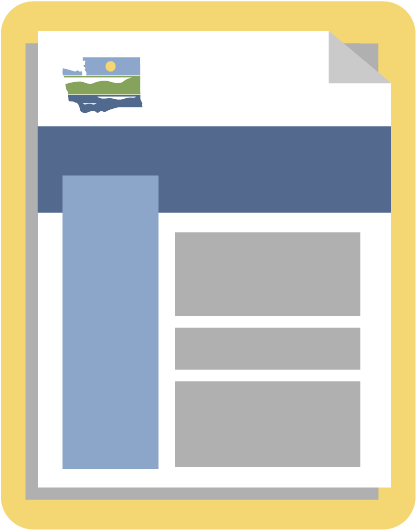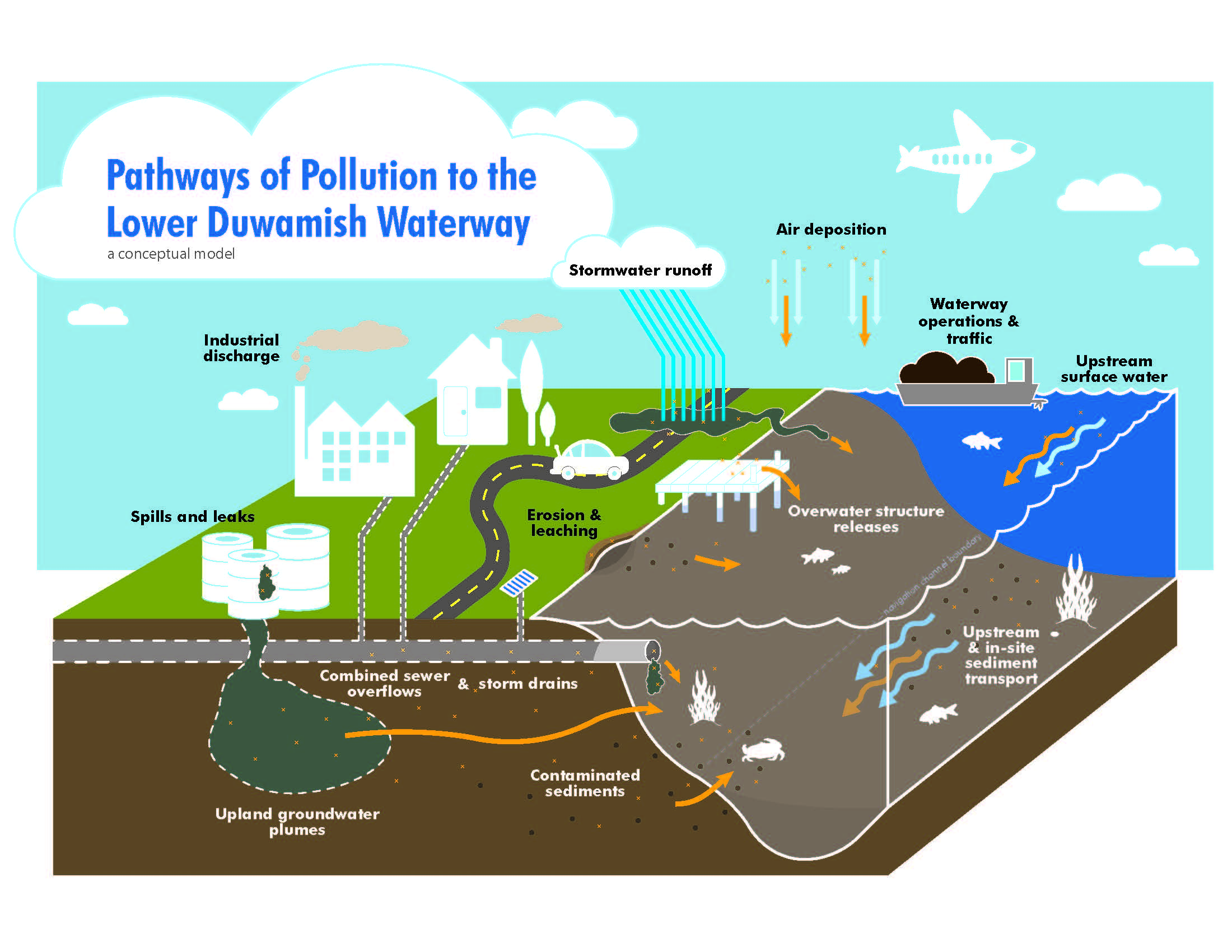Source control
Source control is the process of finding sources of contamination, then stopping or reducing them before they reach the Lower Duwamish Waterway (LDW). We must make sure that sources of contamination to the LDW are sufficiently controlled before in-waterway cleanup begins. This means we must investigate more than 20,000 acres of land that drains into the river.
Read the 2023 Sufficiency report
In the summer of 2023, we submitted a report to the EPA about source control efforts in the upper reach of the LDW. Together with our source control and cleanup partners, we’ve made solid progress on controlling sources of pollution. We’re recommending that the EPA begin cleanup at 28 out of 29 active sediment cleanup locations in the upper reach.
To learn more about the relationship between Ecology's source control efforts and the EPA's in-waterway sediment cleanup in the LDW, download Focus on: Lower Duwamish Waterway Source Control Sufficiency (2022).
Source control includes site investigation and cleanup, business inspections, controlling stormwater runoff and combined sewer overflows, coordination among agencies, and education.
How does pollution get into the river?
Contaminants in the soil and groundwater in the area around the river can find their way into the sediments through storm runoff and other routes (as shown below). The sediments contain a wide range of contaminants due to decades of industrial activity and runoff from urban areas.
Conceptual site model
Source control strategy
Our 2016 Source Control Strategy describes the goals, priorities, and processes for controlling sources of pollution to the LDW. It provides a framework for identifying source control issues and implementing effective controls.
Ecology has defined 24 source control areas. See the source control areas page to read more about the work we've done in these areas.
The short-term goal is to control sources enough to allow in‑waterway cleanup to begin. The long-term goal is to minimize recontamination of the river sediment and restore water quality in the river. However, finding and controlling sources is difficult in an urban environment. Even with aggressive source control, some recontamination will likely occur.
Upstream to downstream approach
We've determined that the most efficient way to manage site cleanups for source control is an upstream to downstream approach. This reduces the problem of contamination from an upstream site moving into a downstream site that has already been cleaned up.
The 24 source control areas are grouped into upper, middle, and lower reaches. The river flows northward, so the upper reach (upstream) starts in Tukwila, and the lower reach (downstream) ends at the southern tip of Harbor Island.
While we will prioritize site cleanups in the upper reach, we will continue to move forward with our work in the middle and lower reaches.
Source Control Work Group
Ecology leads the interagency Source Control Work Group. Much coordination is needed between agencies to control sources of pollution within the 24 source control areas. This group of regulatory professionals meets monthly to share information, discuss strategy, develop action plans, implement source control measures, and track progress.
The Source Control Work Group includes:
- Ecology: Lead for source control at properties that discharge directly to the waterway, as well as at upland contaminated properties.
- City of Seattle: Lead for source control within their storm drain system.
- King County: Lead for source control for discharges to wastewater or combined wastewater and stormwater systems.
- EPA: Provides technical assistance, source control coordination with EPA sediment investigation and cleanup activities.
Source control implementation plans
As the lead agency for source control, we asked the city of Seattle, King County, and EPA to develop agency-specific implementation plans. These plans will be considered part of the Source Control Strategy following their completion.
The intent of the implementation plans is to:
- Set each agency’s priorities for source control for the near-term (five years).
- Establish long-term expectations for source control activities during and following construction of the in-waterway cleanup under the Record of Decision.
City of Seattle source control
- 2021–2026 Lower Duwamish Waterway Source Control Implementation Plan (pdf)
- 2021–2026 Lower Duwamish Waterway Source Control Implementation Plan Appendices (pdf)
- 2021–2026 Source Lower Duwamish Waterway Control Implementation Map Atlas (pdf)
King County source control
Source control status reports
These reports summarize source control activities conducted by the Source Control Work Group. They provide an overview of the LDW site, the strategy for controlling sources of pollutants to the LDW, the process for developing Source Control Action Plans, the methods and process for implementing the Source Control Action Plans, issues associated with permitted discharges, and a summary of source control actions during the period of the report.
Source control status reports (2003–2020):
- January 2020–December 2020
- January 2019–December 2019
- January 2018–December 2018
- January 2017–December 2017
- January 2014–December 2016
- January 2013–December 2013
- January 2012–December 2012
- October 2010–December 2011
- July 2009–September 2010
- September 2008–June 2009
- April 2008– August 2008
- July 2007–March 2008
- 2003–June 2007
Complementary efforts
Ecology and other agencies are engaged in several related efforts that are driven by broader environmental protection and restoration mandates.
Green/Duwamish River Watershed Pollutant Loading Assessment
This joint Ecology and EPA effort, initiated in late 2014, will develop a watershed-based model to:
- evaluate the cumulative effects of toxic pollution;
- assess the relative contribution of toxic pollution from sources and pathways in the watershed; and
- help prioritize efforts to control the release of pollutants in the watershed.
Our Green/Duwamish
King County and the city of Seattle started this regional effort in 2014 to coordinate the work in the watershed that is already being done by local, state, and federal agencies to manage habitat restoration, salmon recovery, flood control, public health, economic development, and more.
Reducing toxic chemicals
Ecology’s Hazardous Waste and Toxics Reduction (HWTR) Program develops comprehensive Chemical Action Plans to identify the most dangerous toxic chemicals and ways to reduce or eliminate them. A Chemical Action Plan for PCBs was published in 2015.
Some of the recommendations in these plans may lead to new legislation or rules, which would go through the normal legislative or rulemaking processes. Other recommendations can be implemented by us and other agencies. Examples of these efforts in the LDW include:
- Sampling building materials for PCBs and contributing to a PCB source tracing program compilation.
- Other agencies working in the LDW are contributing information on products that contain PCBs by testing backfill soils, compost, and mulch.
- Expanding environmental monitoring to identify new areas requiring cleanup. This is a core element of LDW source control and Ecology’s Toxics Cleanup and Water Quality Programs.
Other Ecology efforts to reduce toxics include:
- Testing consumer products for toxic chemicals
- Protecting children through the Children’s Safe Products Act
- Finding safer alternatives to toxic chemicals
- Reducing the use of toxic substances in industry
- Advancing green chemistry
- Supporting strong toxics policy
Related links
Contact information
LDW Email
LDW@ecy.wa.gov
Brett Carp
Aquatics Unit Supervisor
Brett.Carp@ecy.wa.gov
206-496-7007
Ryan Gardiner
Source Control Project Manager
Ryan.Gardiner@ecy.wa.gov
425-681-5543
Kim Wooten, Ph.D.
Toxics Cleanup Program Regional Section Manager
Kim.Wooten@ecy.wa.gov
425-324-1658




